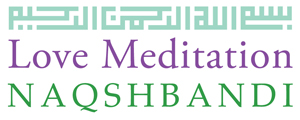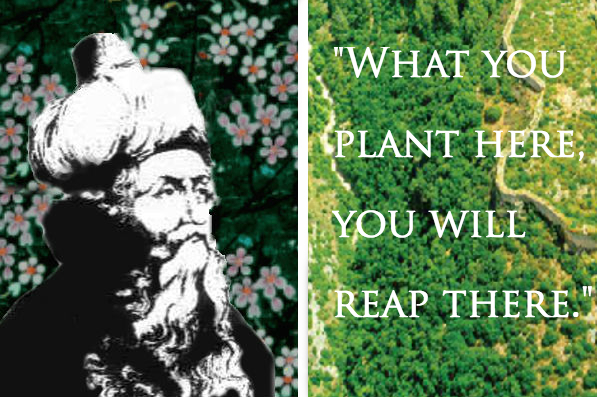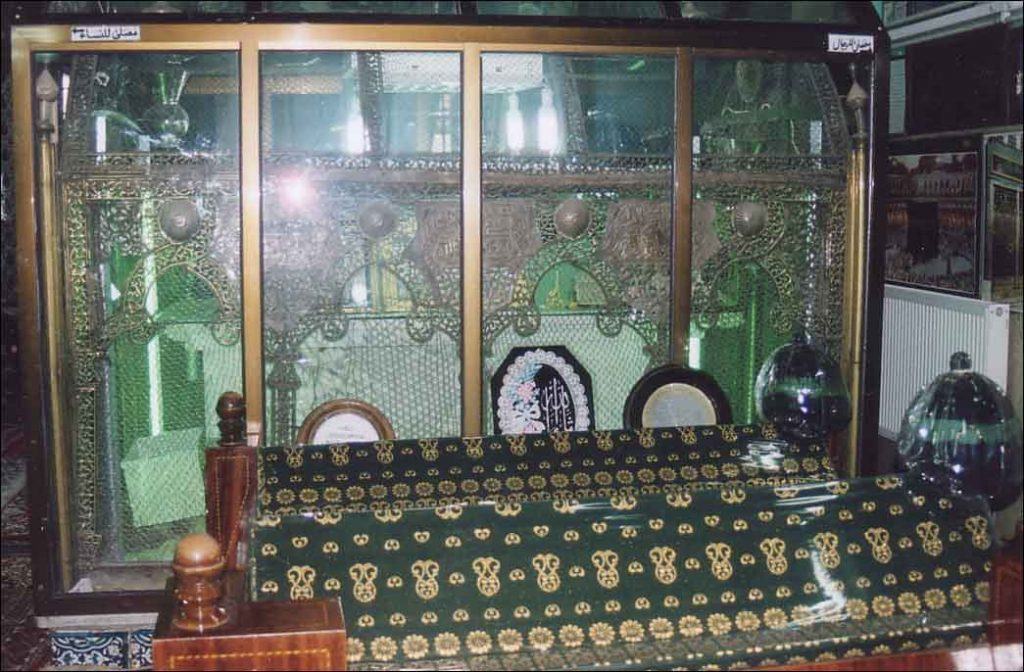Sheikh Muhyiddin Ibn Al-Arabi (RA) – Biography – URS 22nd Rabi al-Thani – (Part 2)
Sheikh Muhyiddin Ibn Al-Arabi RA – URS 22nd Rabi al-Thani
Sheikh Muhyiddin Ibn Al-Arabi RA, the Urs is on 22nd Rabi al-Thani (Fri 20/ Sat 21 January 2017) inshallah. Sheikh Muhyiddin Ibn Al-Arabi RA was also one of the great grandfather’s of our Murshid, Sultan Sheikh Nazim Al-Haqqani (KS) May Allah Almighty continuously raise their maqam and honour them in Divine Presence.
PART (2) TWO CONTINUED …
VISIONS AT THE KAABA
Apart from all this, several visions were granted to him in Makkah. The first took place at night during his circumambulations of the Ka‘ba when he met a young beautiful girl Qurrat al-‘Ayn (Hirtenstein 148). In the second vision, during his circumambulations of the Ka‘ba, he met the mysterious figure who had appeared at the beginning of his ascension and here at Makkah. He said to Ibn ‘ArabI (RA), you should circumambulate in my footstep and observe me in the light of my moon, so that you may take from my constitution that which you write in your book and transmit to your readers (OY: I, 218).
The third vision also occurs at Ka‘ba in a spiritual conversation with the Haram and the Zamzam stream; Ka‘ba ordered him to circumambulate it and the Zamzam told him to drink this pure water but a soft refusal made Ka‘ba angry and he took revenge on a cold and rainy night in the year 600 AH. Shaykh heard the voice of Ka‘ba loud and clear; later in a meditation God taught him the lesson and to express this gratitude Ibn ‘Arab┘ composed a collection of letters in rhymed prose, entitled the Taj al-Rasa’il, in homage to the Ka‘ba.
The next vision is also related to Ka‘ba, in the year 599 AH in Makkah Ibn ‘Arabi (RA) saw a dream which confirms once again his accession to the office of the Seal of the Muhammadian Sainthood. He saw two bricks – one of Gold and the other of Silver – were missing from two rows of the wall of Ka‘ba. He says: “In the mean time I was observing that, standing there, I feel without doubt that I was these two bricks and these two bricks were me …. And perhaps it is through me that God has sealed sainthood” (Addas 213).
In the year 599 AH during circumambulating the Ka‘ba, he encountered the son of Caliph Harun al-Rashid, who had been dead for four centuries and was famous for choosing Saturday for work to gather food for rest of the week. Ibn ‘Arabi (RA) asked him: “Who are you?” He replied: “I am al-Sabti ibn Harun al-Rashid.” Later Ibn ‘Arabi (RA) asked him: “What was the reason of choosing Saturday for work?” He replied: “As God has made this universe in six days from Sunday to Friday, and he rested on Saturday, so I, as His servant worked on Saturday and devoted myself to worshiping Lord for the rest of the week.” In another glorious vision at Ka‘ba Ibn ‘Arabi (RA) saw his forefathers and asked one of them his time, he replied he had been dead around forty thousand years ago. Finally, at Ka‘ba, behind the wall of Hanbalites, Ibn ‘Arabi (RA) was granted the privilege of being able to join a meeting of the seven Abdals (Addas 216).
COUNSEL MY SERVANTS
The message was clear and it was from God; in a passage of Kitab al-Mubashshirat Ibn ‘Arabi (RA) admits that one evening in Makkah he experienced a brief spell of despondency on the face of his disciples, he thought of leaving all counselling, abandon men to their fate and to devote his future efforts to himself alone as those who truly enter the Path are rare. On the same night, he saw himself in dream facing God on the Day of Judgment. In that dream, He said:
“I was standing in front of my Lord, head lowered and fearing that He would punish me for my short comings but he said to me: “Servant of Mine, fear nothing! All I ask of you is that you should counsel My servants” (Addas 218). Faithful to this assurance he would spend the rest of his life giving advice to people from all walks of life, direct disciples, religious authorities and political rulers. This vision probably occurred in the year 600 AH at Makkah, as the very first page of the Ruh al-Quds, written following this revelational order mentions it vividly. According to Osman Yahia; Ibn ‘Arabi (RA) produced 50 of his works after this Divine order, some of which are short epistles of less than 10 pages but all of these are rooted in the Divine order: “Counsel My servants.”
JOURNEY TO THE NORTH
Ibn Arabi’s (RA) life, spanning between 600 to 617 AH is full of journeys, he frequently kept crossing and re-crossing Syria, Palestine, Anatolia, Egypt, Iraq and the Hijaz, yet this physical activity stood in no way in his spiritual pursuits and obligations. The two dimension activity had indeed the same spiritual provenance and was motivated by the sublime purpose of higher life unrelated to egocentricity. The year 600 AH witnessed a meeting between Ibn Arabi (RA) and Shaykh Majduddin Ishaq ibn Yusuf, a native of Malatya and a man of great standing at the Seljuk court. This time Ibn ‘Arabi (RA) was travelling north; first they visited the city of the Prophet Muhammad (SWS) and in 601 AH they entered Baghdad.
This visit besides other benefits offered him a chance to meet the direct disciples of Shaykh ‘Abd al-Qadir Jilani (RA). Shaykh al-Akbar stayed there only for 12 days because he wanted to visit Mosul to see his friend ‘Ali ibn ‘Abdallah ibn Jami’, a disciple of Qadib al-Ban. There he spent the month of Ramadan and composed Tanazzulat al-Mawsiliyya, Kitab al-Jalal wa’l-Jamal and Kunh ma la Budda lil-Murid Minhu (Hirtenstein 176). Here he was invested with the Khirqa of Khidr (AS), transmitted to him by ‘Ali ibn ‘Abdallah ibn Jami’. Later the group travelled north and arrived at Malatya, Majduddin’s hometown and then to Konya. In Konya Ibn ‘Arabi (RA) met with Awhaduddin Hamid Kirmani, who became his friend like Majduddin. He transmitted to Ibn ‘Arabi (RA) teachings and stories of the many great spiritual masters of the East. Over the next 20 years Ibn ‘Arabi (RA) and Kirmani remained close friends and companions (Hirtenstein 179).
After spending 9 months in Konya, he returned to Malatya where Kayka’us, one of the Kaykhusraw’s sons, had been made ruler of Malatya. Majduddin was appointed as his tutor and Ibn ‘Arabi (RA) also became involved in the young prince’s education.
RETURN TO THE SOUTH
In the year 602 AH he visited Jerusalem, Makkah and Egypt. It was his first time that he passed through Syria, visiting Aleppo and Damascus. In Jerusalem, he continued writing, and 5 more works were completed. These are: Kitab al-Ba’, Isharat al-Qur’an. In May 602 AH he visited Hebron, where he wrote Kitab al-Yaqin at Masjid al-Yaqin near the tomb of Prophet Ibrahim (AS) (Yusuf 307).
The following year he headed toward Cairo, staying there with his old Andalusian friends , including Abu al-‘Abbas al-Harrar, his brother Muhammad al-Khayyat and ‘Abdallah al-Mawruri. In Cairo Ruh al-Quds and Kitab Ayyam al-Sha’n were read again before Ibn ‘Arab┘, with the reader this time being a young man named Isma’il ibn Sawdakin al-Nuri (Yusuf 309). Like Badr al-Habashi, Ibn Sawdakin attached himself to Ibn ‘Arabi (RA) forever. He left value-oriented commentaries on the works of Ibn ‘Arabi (RA) notably Mashahid al-Asrar, Kitab al-Isra’ and the Kitab al-Tajalliyat. His house in Aleppo was often used for the reading of Ibn ‘Arabi’s (RA) works over the next 40 years (Yusuf 311).
Later in 604 AH he returned to Makkah where he continued to study and write, spending his time with his friend Abu Shuja bin Rustem and family, including the beautiful Nizam (II, 376; Hirtenstein 181). The next 4 to 5 years of Ibn ‘Arabi’s (RA) life were spent in these lands and he also kept travelling and holding the reading sessions of his works in his own presence.
BAGHDAD, CITY OF THE SAINTS
In the year 608 we find him in Baghdad with his friend MajduddIn Ishaq and there he met the famous historian Ibn al-Dubaythi and his disciple Ibn al-Najjar. In Baghdad, he had a terrifying vision regarding the Divine deception (makr), In which he saw the gates of heaven open and the treasures of Divine deception fell like rain on everyone. He awoke terrified and looked for a way of being safe from these deceptions. The only safe way he found is by knowing the balance of the Divine law.
According to Osman Yahia in Baghdad Ibn ‘Arabi (RA) met with the famous Sufi Shihabuddin Suharwardi (d. 632), author of the ‘Awarif al-ma’arif who was personal advisor to Caliph al-Nasir. In this meeting, they stayed together for a while, with lowered heads and departed without exchanging a single word. Later Ibn ‘Arab┘ said about Suharwardi: “He is impregnated with the Sunna from tip to toe” and Suharwardi said about Ibn ‘Arabi (RA): “He is an ocean of essential truths (bahr al-Haqaiq).
TARJUMAN AL-ASHWAQ
In the year 611 he was again in Makkah, where his friend Abu Shuja had died two years before. Ibn ‘Arabi (RA) performed Hajj and started compilation of his most famous poetic work the Tarjuman al-Ashwaq. After Hajj Ibn ‘Arabi (RA) left Makkah, travelling north towards the Roman lands, probably Konya or Malatya and in the year 610/611 he returned to Aleppo. In Aleppo this work caused uproar and consternation in certain quarters, since he came under the blame of writing erotic verses under the cover of poetic allusions. The jurists from Allepo severely criticized the claim that this poetry was a mystical or expresses Divine realities, which made his disciples very upset. Later on the request of his two disciples, Ibn Sawdakin and Badr al-Habashi he wrote a commentary on these poems by the title of “Dhakha’ir al-A’laq” in a great hurry. It was completed in Anatolia in 612. When the jurists heard this commentary, they felt sorry for unjustly exposing Ibn ‘Arab┘ to scathing criticism (Yusuf 335).
IN SIVAS AND MALATYA
The period of extensive travelling came to an end and for the next few years he seems to have made his home in the Seljuk Kingdom. In the year 612 AH, at Sivas he had a vision anticipating Kayka’us victory at Antioch over the Franks. He wrote a poem in which he enlightened the Sultan of the vision and his future victory. Later Ibn ‘Arabi (RA) returned to Malatya and according to Stephen Hartenstein he met Baha’uddin Walad, father of the famous Persian Poet Jallaluddun Rumi (RA), the famous Persian poet of that time. Little Rumi was with his father and after the meeting when Baha’uddin left with his son tagging along behind him, Shaykh al-Akbar said: “What an extraordinary sight, a sea followed by an ocean!” (Hirtenstein 188).
His reading and writings continued in Malatya, where in 615 AH, we find hearings of Ruh al-Quds, finalization of The Tarjuman al-Ashwaq and compilation of a short epistle on the technical terms of Sufism: the Istilahat al-sufiyya. The year 617 was the year of mourning for him as he lost one of his best friends Majduddin Ishaq, Ibn ‘Arabi (RA) took charge of the upbringing of the young Sadruddin and married the widow as it was necessary according to the customs of the time. (Hirtenstein 189). Lastly his close companion and valet, friend and fellow, traveller on the way of God Badr al-Habashi died.
DAMASCUS THE LAST DAYS
After criss-crossing the east for a period of 20 years Ibn ‘ArabI (RA) now decided to settle in Syria and spent the last 17 years of his life in Damascus, the city was already known quite well to him, he had several contacts with leading notables there. He was greeted in Damascus as a spiritual master and a spacious house was provided to him by the Grand Qadi of the town Ibn Zaki. In Damascus, he devoted himself to writing and teaching to fulfil the commandment of his Lord: “Counsel My servants.” The first thing he did was to collect and disseminate the works which had already been written, copies were made and reading sessions took place in his house. Kitab al-Tajalliyat was one of these first books to record such a certificate (sima‘) in the presence of his disciple Ibn Sawdak┘n. In the year 621 AH eight more works bore these hearing certificates, among these were: Kitab al-Yaqin, Al- Maqsid al-Asmá, Kitab al-Mim wal-Waw wal-Nun, Mafatih al-Ghayub and Kitab al-Haqq. At the same time, Ibn ‘Arab┘ devoted his attention to complete the lengthy Futuhat, many volumes of this book came into being in this period.
During this period of his life, he imparted direct instructions to many of his disciples including Sadruddin al-Qunawi. He brought up alongside Ibn ‘Arabi (RA) own family in Malatya and after the death of his real father Qunawi joined Shaykh al-Akbar in Damascus. He accompanied and served Kirmani on his travels in Egypt, Hijaz and Iran. In his private collection Sadruddin wrote that he had studied 10 works of Ibn ‘Arabi (RA) under him and later Ibn ‘Arabi (RA) gave him a certificate to freely relate them on his authority. He studied and discussed with Ibn ‘Arabi (RA) no less than 40 works, including the whole text of Futuhat in 20 volumes.
VISIONS AT DAMASCUS
Ibn ‘ArabI (RA) had several visions of the Prophet Muhammad (SWS) at Damascus. In 624 AH he had been told by the Messenger of Allah that angles are superior to men. In the same year, he had another discussion with the Prophet, this time Prophet replied to him regarding the resurrection of animals: “Animals will not be resurrected on the Day of Judgement.” (I, 527; Addas 275) In the third vision he was ordered by the Prophet to write a poem in favour of al-Ansar. In this vision Ibn ‘Arabi (RA) was informed that his mother was from al-Ansar’s tribe (I, 267). In the fourth vision, at the end of Muharram 627 AH the Prophet came to him once again and handed him the book Fusus al-Hikam (The Bezels of Wisdoms). Ibn ‘Arabi (RA) started writing this book with all the purity of his intentions and his deepest aspirations. He said: “I state nothing that has not been projected toward me; I write nothing except what has been inspired in me. I am not a Prophet nor a Messenger but simply an inheritor; and I labour for my future life” (Ibn ‘Arabi (RA), “Fusus al-Hikam” 47). In the same year just over two months after receiving the book of the Fusus he had a vision of Divine Ipseity, it’s exterior and interior which he had not seen before in any of his witnessings.
THE FUTUHAT OF MAKKIYYA
In 629 AH the first draft of al-Futuhat al-Makkiyya was completed. The book has hundreds of manuscript in various libraries of the world, the most important of them is the manuscript of Konya, written by its author. This book had taken the best part of his thirty years and Ibn ‘Arabi (RA) dedicated it to his eldest son, ‘Imaduddin Muhammad. It contains 560 chapters of esoteric knowledge and is truly the encyclopaedia of Islamic Sufism. The book is divided into six sections and these are:
1. Spiritual Knowledge (al-ma‘arif)
2. Spiritual Behaviour (al-ma‘lumat)
3. Spiritual States (al-ahwal)
4. Spiritual Abodes (al-manazil)
5. Spiritual Encounters (al-munazalat)
6. Spiritual Stations (al-maqamat)
Chapter 559 contains the mysteries and secrets of all the chapters of the book, so we can say that it is like a summary of the whole Futuhat. In the 48th chapter of the Futuhat, he says that the content of the message and the form of its presentation have been determined by Divine Inspiration.
Three years later in 632 AH, on the first of Muharram, Ibn ‘Arabi (RA) embarked on a second draft of the Futuhat; this he explained, included a number of additions and a number of deletions as compared with the previous draft. This revision completed in the year 636 (Addas 286). After completion of this 2nd draft, he started teaching it to his disciples. Dr. Osman Yahia has mentioned hundreds of these hearings or public readings that occur between the year 633 AH and 638 AH. These hearings show that the Futuhat was a primary document of his concepts and was widespread in his life in comparison with the Fusus al-Hikam, which has only one Sam┐’ given to only Sadruddin al-Qunawi.
Finally on 22 Rabi‘ al-Thani 638 AH at the age of seventy-five (75), Ibn ‘Arabi’s (RA) worldly life came to an end. He was present at the house of Qadi Ibn Zaki at the time of death, Jamaluddin ibn ‘Abd al-Khaliq, ‘Imad Ibn Nahhas and his son ‘Imaduddin performed his funeral rites. He was buried in the family tomb of the Banu Zaki in the small beautiful district of Salihiyya at Jabal Qasiyun.
(Source: From authenticated sources by Abrar Ahmed Shahi
Ibn Arabi Foundation )
*************************
In honour of this great Saint of Allah Almighty we recite 3 x Surah Ikhlas and Bir hurmati Habib bir hurmati Sirri Surat Al-Fatiha.



